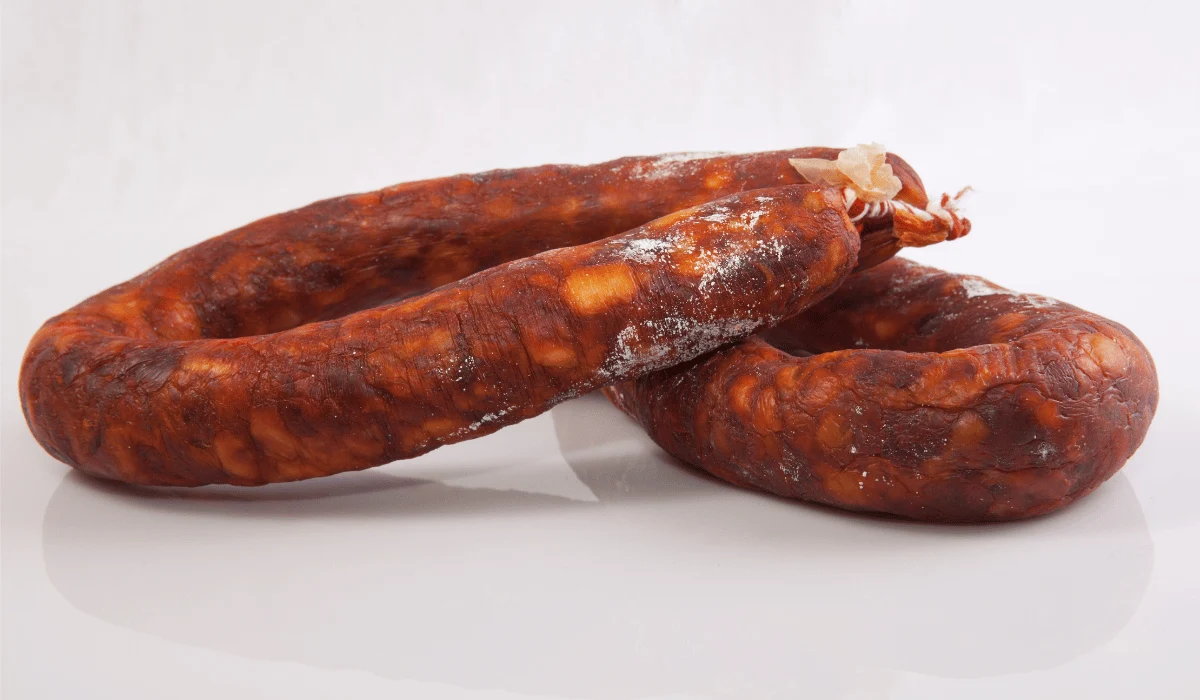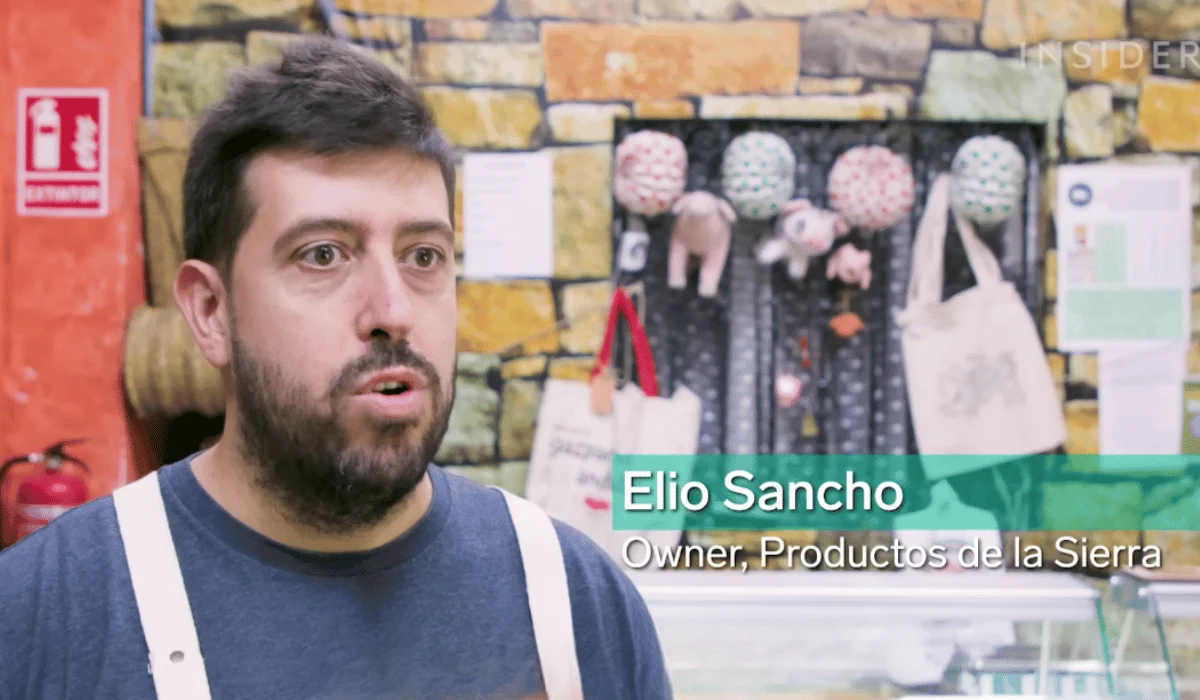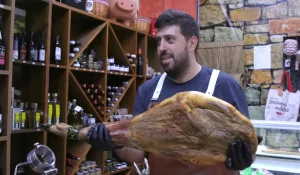Article Summary
Spanish chorizo is much more than a red, spicy sausage. This article reveals five secrets: the incredible variety of chorizo, the exceptional Iberian pigs that provide its rich flavor, the essential smoky pimentón, the artisanal handcrafting process, and the surprising step of piercing the sausages to allow them to breathe. From pasture to plate, chorizo embodies centuries of tradition, meticulous care, and the heart of Spanish gastronomy.
My name is Elio, and for as long as I can remember, my life has revolved around the incredible food culture of my beloved Seville. As a tapas guide, I’ve had the pleasure of showing people from all over the world the true heart of Andalusian cuisine. It’s a passion that runs deep. In fact, over five years ago, I had the incredible opportunity to share some of this passion when the American channel Insider Food came to town. We filmed a segment right here in my shop, “Productos de la Sierra,” diving into what makes our chorizo so special. It was a wonderful experience, a chance to show a global audience that what they often see as simple Spanish sausage is actually a world of complex history, craft, and flavor.
Today, I want to take you on that same journey, but even deeper. Most people think of chorizo as a simple, red, spicy sausage. And while that’s not wrong, it’s like saying the ocean is just wet. It barely scratches the surface. The story of authentic Spanish chorizo is a rich tapestry woven with threads of ancient history, unique animal husbandry, and meticulous artisanal techniques.
Forget everything you thought you knew. Let’s uncover the five secrets that truly define this jewel of Spanish gastronomy.
1. A World of Chorizo: It’s Not All Red and Spicy
First, let’s clear up the biggest misconception. The chorizo you find outside of Spain is often a one-dimensional caricature of the real thing. Here, chorizo is a universe of its own, with thousands of regional variations. The tradition of sausage making itself was brought to the Iberian Peninsula by the Romans, but over centuries, we Spaniards made it our own, transforming it into the chorizo we know and love today.
The most fundamental distinction is between fresh chorizo, which needs to be cooked, and dry-cured chorizo, which is ready to be sliced and savored as is. But the variety goes much further.
Did you know there’s a chorizo that isn’t red at all? It’s called chorizo blanco (white chorizo). This variety forgoes pimentón entirely, instead getting its distinct, peppery flavor from ground black pepper and garlic. It’s a completely different but equally delicious experience.
Even within the world of red chorizo, the nuances are vast. The flavor profile is determined by the type of pimentón used. We have chorizo dulce (sweet chorizo), made with a mild, sweet paprika that gives a rich, round flavor without any heat. Then there’s chorizo picante (spicy chorizo), which uses a hot paprika to deliver that fiery kick many people associate with the name. The quality of this single ingredient is so paramount that it deserves its own secret.
2. The Heart of the Flavor: The Noble Iberian Pig
You cannot speak of the finest chorizo without talking about the pig it comes from. While good chorizo can be made from white pigs, the absolute pinnacle of quality is chorizo ibérico de bellota. This isn’t just a label; it’s a guarantee of a product born from a unique animal and a unique environment.
The chorizo we are most proud of here in Andalusia comes from the cerdo ibérico, the native black Iberian pig. These are majestic animals, distinguished by their dark skin and black hooves, which is why the finest ham is known as pata negra. But what truly sets them apart is their upbringing.
These pigs live a life of luxury, roaming freely across vast landscapes of oak forests known as the dehesa. This is what we call an “extensive” farming system. As I explained to the Insider Food team all those years ago, this lifestyle is the foundation of quality.
“The more muscular the pig gets, the less fat it has.”
By constantly moving and foraging, the pigs develop strong, lean muscles.
Their diet during the final months of their lives, the montanera period, consists almost exclusively of bellotas (acorns). This acorn-rich diet infuses their fat with oleic acid—the same healthy fat found in olive oil—giving it a unique, nutty flavor and a texture that literally melts in your mouth.
“The meat on it and the fat it has left is of much better quality, and it has a taste that’s completely different to other pigs.”
This isn’t just pork; it’s the essence of the Spanish dehesa captured in every single bite.
3. The Soul of Chorizo: The Sanctity of Pimentón
If the Iberian pig provides the perfect canvas, then pimentón (paprika) is the paint that brings the masterpiece to life. This spice is non-negotiable. It is the very soul of red chorizo, responsible for two of its most defining characteristics: its vibrant red color and its deep, smoky flavor.
When you see that rich, crimson hue, you’re seeing the work of finely ground, dried peppers. But not just any peppers. The best Spanish pimentón, like the famous Pimentón de la Vera, is made from peppers that are slowly dried over oak wood fires. This process imparts a complex, smoky aroma and taste that permeates the meat during the curing process.

Quality here is everything. Using a cheap, inferior paprika would be a sacrilege. It would not only fail to provide the right color but would also leave a dusty, bitter aftertaste. As I always say:
“It’s very important to use really high-quality spices in the chorizo. Because if we use lower-quality spices, it follows that the taste of the chorizo will also be lower quality.”
A true maestro choricero understands that the integrity of the final product depends entirely on the quality of its simplest ingredients.
4. A Ritual of Hands: The Enduring Artisanal Process
In an age of mass production, the creation of true Iberian chorizo remains a deeply human, artisanal craft. At traditional obradores like Jamones Lazo in the province of Huelva, where Insider Food filmed the process, you see that the most important tools are still the hands of the artisans.
The process begins after the prime cuts of Iberian pork—cuts of lean meat known as magro and finer meats—are selected and minced. This meat is then left to rest for 24 hours in a cold chamber. Following this rest, the seasoning is added: salt, garlic, and, of course, the all-important pimentón.
This next step is crucial: the mixing is done entirely by hand. Workers knead the meat and spices together with practiced, rhythmic movements, ensuring every ounce of pork is perfectly infused with flavor. This manual process is something a machine could never replicate with the same care.
Once mixed, the meat is fed into a stuffing machine that gently fills natural casings (tripa natural). But even here, technology only plays a supporting role. The final, delicate step of tying off each chorizo link with string is, once again, performed by hand, a tradition passed down through generations.
5. The Secret Breath: A Sausage That Must Be Pierced to Live
Here is the secret that surprises everyone, even seasoned food lovers. Once the chorizo has been stuffed into its casing and tied, you might think it’s ready for curing. But there is one more vital, and seemingly strange, step. An artisan takes a small, pointed tool and carefully pierces the skin of each sausage multiple times.
Why would you puncture a perfectly sealed sausage? The chorizo needs to breathe.
As the presenter in the factory explained, this is done to release any air that may have been trapped inside during the stuffing process. If this air were left, it would create pockets that prevent even drying and could cause the chorizo to spoil. She said it would “implode,” and in a way, she’s right. The piercing allows the meat to settle and the curing process to begin uniformly.
The effect is almost immediate. You can watch as the chorizo begins its transformation. The color starts to deepen, and the sausage firms up as the moisture begins to escape. These fresh chorizos, only minutes old, are then hung on racks to begin their slow journey of curing. They spend about a month in cool stores, where they slowly lose water and the flavors concentrate and mature. Finally, they are moved to natural cellars, the same bodegas used for curing ham, where they finish their development, acquiring the final taste and aroma that makes them so irresistible.

How to Savor Chorizo Like a Spaniard
Now that you know its secrets, how should you enjoy it? Here in Seville, chorizo is a cornerstone of our tapas culture. You’ll find it simply served with good crusty bread and a glass of wine or a cold beer. But it’s also a star ingredient in many beloved dishes.
One of the most popular is huevos rotos con patatas y chorizo, a hearty dish of fried potatoes and eggs, broken up and mixed with savory chunks of chorizo. It’s simple, rustic, and absolutely divine. It’s also an essential component in many stews, most famously the cocido de garbanzos (chickpea stew), where it lends its smoky fat and rich flavor to the entire pot.
But a word of warning from a true Sevillano: as much as we love it, there is one place you will not find authentic chorizo. As I emphatically told the Insider team, shaking my finger at the camera:
“Not paella! No paella!”
The powerful flavor of pimentón would overwhelm the delicate saffron and other ingredients of a traditional paella. That’s a rule to live by!
From the open dehesa to the artisan’s hands, and from the smoky pimentón to its final breath before curing, chorizo is so much more than a sausage. It is a story, a tradition, and a taste of Spain itself. The next time you enjoy a slice, I hope you’ll savor it with a newfound appreciation for the incredible journey it has taken to reach your plate.
Author

I’m Elio Tovani, a local Sevillian guide with WSET Level 2 certification. Through the Seville Tapas Tour, I combine history, culture, and gastronomy in small, authentic experiences across my city’s most charming neighborhoods. My passion for wine and Andalusian traditions drives me to share the real taste of Seville with every guest.




